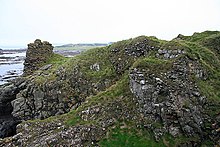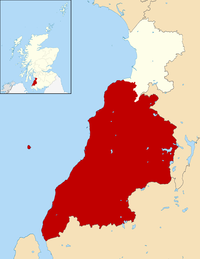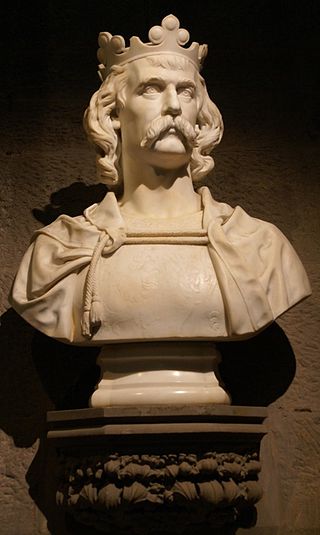
Robert I, popularly known as Robert the Bruce, was King of Scots from 1306 to his death in 1329. Robert led Scotland during the First War of Scottish Independence against England. He fought successfully during his reign to restore Scotland to an independent kingdom and is regarded in Scotland as a national hero.

Girvan is a burgh and harbour town in Carrick, South Ayrshire, Scotland. Girvan is situated on the east coast of the Firth of Clyde, with a population of about 6,450. It lies 21 miles (34 km) south of Ayr, and 29 miles (47 km) north of Stranraer, the main ferry port from Scotland to Northern Ireland.

Earl of Carrick is the title applied to the ruler of Carrick, subsequently part of the Peerage of Scotland. The position came to be strongly associated with the Scottish crown when Robert the Bruce, who had inherited it from his maternal kin, became King of the Scots in the early 14th century. Since the 15th century, the title of Earl of Carrick has automatically been held by the heir apparent to the throne, thus the current holder of the title is Prince William, Duke of Rothesay.

Marjorie Bruce or Marjorie de Brus was the eldest daughter of Robert the Bruce, King of Scots, and the only child born of his first marriage with Isabella of Mar.
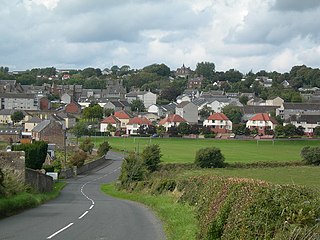
Maybole is a town and former burgh of barony and police burgh in South Ayrshire, Scotland. It had an estimated population of 4,580 in 2020. It is situated 9 miles (14 km) south of Ayr and 50 miles (80 km) southwest of Glasgow by the Glasgow and South Western Railway. The town is bypassed by the A77.
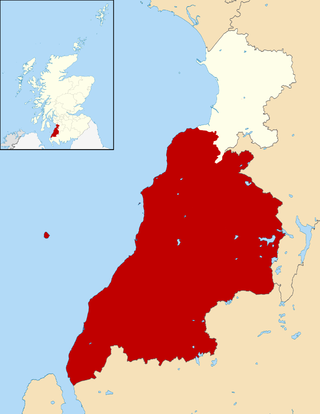
Carrick is a former comital district of Scotland which today forms part of South Ayrshire.
Marjorie of Carrick was Countess of Carrick, Scotland, from 1256 to 1292, and is notable as the mother of Robert the Bruce.

Stewarton is a town in East Ayrshire, Scotland. In comparison to the neighbouring towns of Kilmaurs, Fenwick, Dunlop and Lugton, it is a relatively large town, with a population estimated at over 7,400. It is 300 feet above sea level. The town is served by Stewarton railway station.

Dunure Castle is located on the west coast of Scotland, in South Ayrshire, about five miles south of Ayr and close to the village of Dunure. Today the castle stands in ruins on a rocky promontory on the Carrick coast, overlooking the small harbour of Dunure.
Robert de Brus, 6th Lord of Annandale, jure uxoris Earl of Carrick (1252–1292), Lord of Hartness, Writtle and Hatfield Broad Oak, was a cross-border lord, and participant of the Second Barons' War, Ninth Crusade, Welsh Wars, and First War of Scottish Independence, as well as father to the future king of Scotland Robert the Bruce.

The Abbey of Saint Mary of Crossraguel is a ruin of a former abbey near the town of Maybole, South Ayrshire, Scotland. Although it is a ruin, visitors can still see the original monks’ church, their cloister and their dovecot.

The Battle of Loudoun Hill was fought on 10 May 1307, between a Scots force led by King Robert the Bruce and the English commanded by Aymer de Valence, Earl of Pembroke. It took place beneath Loudoun Hill, in Ayrshire, and ended in a victory for King Robert. It was the king's first major military victory. The battlefield is currently under research to be included in the Inventory of Historic Battlefields in Scotland and protected by Historic Scotland under the Scottish Historical Environment Policy of 2009.
Christian or Christina Bruce, also known as Christian or Christina de Brus, was a daughter of Marjorie, Countess of Carrick, and her husband, Robert de Brus, jure uxoris Earl of Carrick, as well as a sister of Robert the Bruce, King of Scots. It is presumed that she and her siblings were born at Turnberry Castle in Carrick.
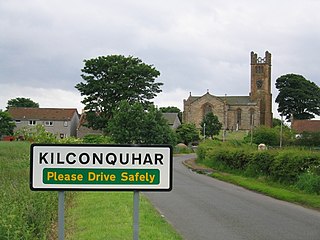
Kilconquhar is a village and parish in Fife in Scotland. It includes the small hamlet of Barnyards. It is bounded by the parishes of Elie, Ceres, Cameron, St Monans, Carnbee, Newburn and Largo. It is approximately 9 miles from north to south. Much of the land is agricultural or wooded. The village itself is situated inland, north of Kilconquhar Loch. Also in the civil parish are Colinsburgh and Largoward, the latter since 1860 being a separate ecclesiastical parish.

Kirkoswald is a village and parish in the Carrick district of Ayrshire, Scotland, 1+3⁄4 miles from the coast and four miles southwest of Maybole. It takes its name from its kirk (church), dedicated to Oswald of Northumbria, who is said to have won a battle here in the 7th century. The old church, which was built in 1244 and houses the baptismal font of Robert the Bruce, is now a ruin in the grounds of the modern church, which was built in 1777 to a design by Robert Adam. Kirkoswald is also noted for its connection with Robert Burns, whose maternal ancestors, the Brouns, were from the village. Burns also attended school here, and would later base the characters Tam o' Shanter, Kirkton Jean and souter Johnnie on village locals Douglas Graham, Jean Aird and John Davidson, the shoemaker.
Nigel de Brus was a younger brother of King Robert I of Scotland. Born at Carrick, Ayrshire, Scotland, he was a son of Robert de Brus, 6th Lord of Annandale and Margaret, Countess of Carrick. He supported his older brother in the struggle for the crown of Scotland and fought in the Wars of Scottish Independence.
The Turnberry Band, also known as the Turnberry Bond, was a pact between Scottish and Anglo-Irish nobles signed on 20 September 1286 at Turnberry Castle, Ayrshire, Scotland. The agreement may have concerned a campaign in Ireland, and may have later formed the basis that bound the group around the claim of the Bruce family to the Scottish throne.
The Battle of Turnberry was a battle fought in February 1307 during the Scottish Wars of Independence near Turnberry, Ayrshire, Scotland.

Maybole Castle is a 16th-century castle located on High Street in Maybole, South Ayrshire, Scotland. Originally built for the Earls of Cassillis, it is an L-shaped construction with Victorian two-storey extensions. It is associated with a legend of John Faa, in which an earl killed Faa and imprisoned his wife, the Countess of Cassilis, in the castle.
